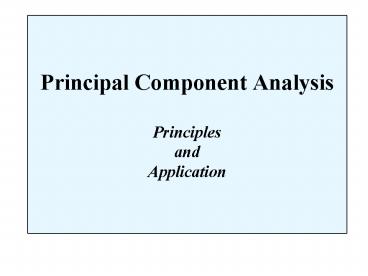Principal Component Analysis Principles and Application - PowerPoint PPT Presentation
1 / 29
Title:
Principal Component Analysis Principles and Application
Description:
Principal Component Analysis Principles and Application Large Data Sets Examine the Statistics Examine the Statistics Rotate coordinates to remove the correlations ... – PowerPoint PPT presentation
Number of Views:250
Avg rating:3.0/5.0
Title: Principal Component Analysis Principles and Application
1
Principal Component AnalysisPrinciples and
Application
2
- Examples
- Satellite Data
- Digital Camera, Video Data
- Tomography
- Particle Imaging Velocimetry (PIV)
- Ultrasound Velocimetry (UVP)
3
Large Data Sets
Low resolution image
- There are 400 x 600 240,000 pieces of
information. - Not all of this information is independent
- gt information compression (data compression)
4
Example 1 Two component velocity measurement
- Experiment
- Consider the flow past a cylinder, and suppose we
position a cross-wire probe downstream of the
cylinder. - With a cross-wire probe we can measure two
components of the velocity at successive time
intervals and store the results in a computer.
5
Mathematical Representation of Data
6
Basic Statistics
- Mean velocity
- Variance
- Covariance
- Correlation
7
Plot u vs v
The data look correlated
8
Examine the Statistics
Move to a data centered coordinate system
9
Examine the Statistics
Move to a data centered coordinate system
10
Rotate coordinates to remove the correlations
11
We have just carried out a Principal Axis
Transformation. This is the first step in
a Principal Component Analysis (PCA).
12
Principal Component Analysis A procedure for
transforming a set of correlated variables into a
new set of uncorrelated variables. How do we do
it??
13
Construction of the PCA coordinate system
- The PCA coordinate system is one that maximizes
the mean squared projection of the data. In this
sense it is an optimal orthogonal coordinate
system. Its popularity is primarily due to its
dimension reducing properties. - The basic algorithm for constructing the PCA
eigenvectors is - Find the best direction (line) in the space,
?1. - Find the best direction (line) ?2 with the
restriction that it must be orthogonal to ?1. - Find the best direction (line) ?i with the
restriction that ?i is orthogonal to ?j for all j
lt i.
14
How do we find this nice coordinate system??
Calculate the eigenvalues and eigenvectors of
the Covariance Matrix
15
Example 2. Velocity Profile Measurement
- Experiment
- Pipe Flow -- measurement of velocity profile.
u(z)
z
16
Vectors in Profile Space
- As before we represent the velocities in the form
of a column vector, but this time the vector is
not in physical space. - The space in which our vector lives is one we
shall call profile space or pattern space. - Profile space has n dimensions. In this
example, the position zk defines a direction in
profile space. - As time evolves, we measure a sequence of
velocity profiles
17
(No Transcript)
18
The Preliminary Calculations
19
The Diagonalization
20
Example 3.Taylor-Couette Flow
21
UVP Example
Covariance Matrix
22
The Eigenvalue Spectrum(Signal) Energy Spectrum
23
Filtering and Reconstruction
- Decompose X into signal and noise dominated
components (subspaces) - where XF is the Filtered data
- XNoise is the Residual
- Reconstruct filtered UVP velocity
24
(No Transcript)
25
Eigenvalue Spectrum
26
Filtered Time Series(Channel 70)
Raw data
Filtered data
Residual
27
Power Spectra(Integrated over all channels)
28
Superimpose the Spectra
29
Generalizations
- Generalise
- Response to a stimulus
- Comparison of multiple data sets obtained by
varying a parameter to study a transition.

